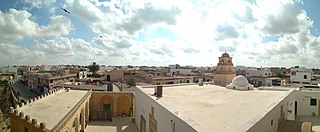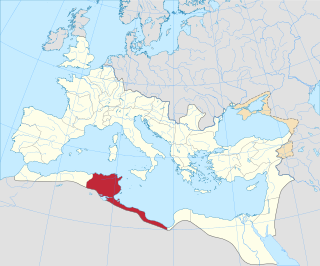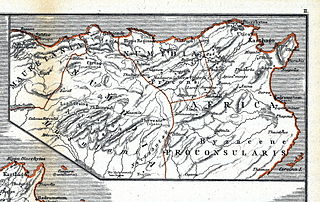
Byzacena was a Late Roman province in the central part of Roman North Africa, which is now roughly Tunisia, split off from Africa Proconsularis.

El Djem or El Jem is a town in Mahdia Governorate, Tunisia. Its population was 21,576 during the 2014 census. It is home to Roman remains, including the Amphitheatre of El Jem.

Theveste was a Roman colony situated in the present Tébessa, Algeria.

Thuburbo Majus is a large Roman site in northern Tunisia. It is located roughly 60 km southwest of Carthage on a major African thoroughfare. This thoroughfare connects Carthage to the Sahara. Other towns along the way included Sbiba, Sufes, Sbeitla, and Sufetula. Parts of the old Roman road are in ruins, but others do remain.
Usilla or Usula was a town in the Roman province of Byzacena, now Inchilla in Tunisia.

Thelepte was a city in the Roman province of Byzacena, now in western Tunisia. It is located near the border with Algeria about 5 km north from the modern town of Fériana and 30 km south-west of the provincial capital Kasserine.

The Catholic Church in Tunisia is part of the worldwide Catholic Church, under the spiritual leadership of the Pope in Rome.
Sufes was a town in the late Roman province of Byzacena, which became a Christian bishopric that is included in the Catholic Church's list of titular sees.
Noël Duval was a French archaeologist.

The Fossa Regia, also called the Fosse Scipio, was the first part of the Limes Africanus to be built in Roman Africa. It was used to divide the Berber kingdom of Numidia from the territory of Carthage that was conquered by the Romans in the second century BC.
Pierre Salama was a French historian and archaeologist, specialist of Roman roads in Africa as well as milestones. An epigrapher, numismatist, he was also a specialist of historical geography.

Roman colonies in North Africa are the cities—populated by Roman citizens—created in North Africa by the Roman Empire, mainly in the period between the reigns of Augustus and Trajan.

Abbir Germaniciana also known as Abir Cella is the name of a Roman and Byzantine-era city in the Roman province of Africa proconsularis. The city was also the seat of a bishopric, in the ecclesiastical province of Carthage, and is best known as the home town of the Pre Nicaean father, Cyprian, who was bishop of Abbir Germaniciana around 250AD.

Auzegera was a Roman-Berber town in the province of Africa Proconsularis and in late antiquity Byzacena. It was a Catholic Church diocese.
Henchir-Khachoum is a locality and series of archaeological sites in Sidi Bouzid Governorate modern Tunisia. The ruins are strewn along a tributary of the Oued El Hatech river east of Sbeitla. During the Roman Empire there was a Roman town of the Roman province of Africa Proconsularis, called Muzuca, one of two North African towns to bare that name.
Ksour-el-Maïete is a set of ruins in Tunisia near the Cherita and the Sebkhet de Sidi El Hani lakes.
Bir el Menadla (Bir el Menadla) is a locality and archaeological site in Governorate de Mahdia (Al Mahdiyah), Tunisia (North Africa).
Henchir-Merelma is a locality and archaeological site in the Mahdia Governorate of Tunisia.

Numidia was a Roman province on the North African coast, comprising roughly the territory of north-east Algeria.














